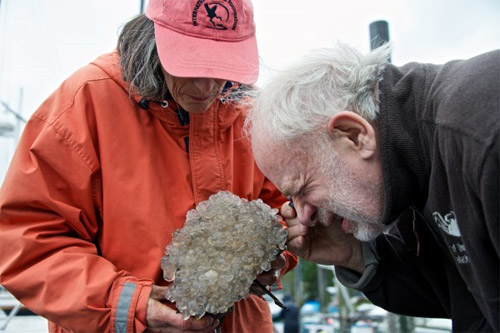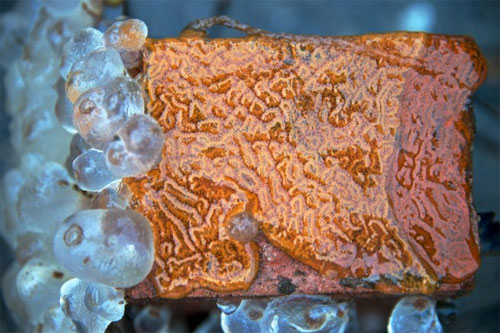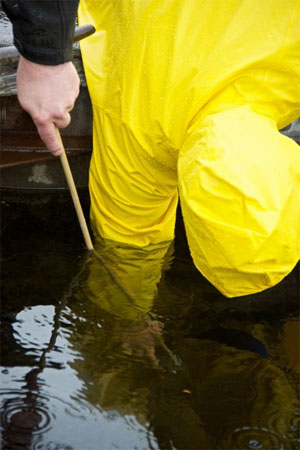
Marine invasive species get bioblitzed in KetchikanBy DEBORAH MERCY
March 15, 2014
So researchers who track the newcomers have enlisted volunteer reinforcements - the people who live along the coast. Sarah Cohen researcher (San Francisco State University) and Gary Freitag Alaska Sea Grant Marine Advisory Ketchikan Agent, identify a marine invasive tunicate.
D. vex was found during a bioblitz event. “A bioblitz is a very short, volunteer-led assessment of all the species living in an area,” explained Linda McCann, researcher with the Smithsonian Environmental Research Center. In September 2013, Smithsonian researchers partnered with Gary Freitag, Alaska Sea Grant Marine Advisory Program agent in Ketchikan, to hold a different kind of bioblitz. “This time, we turned the bioblitz concept upside down. We don’t want to look for everything. We only want to look for the marine invasives,” McCann said.
A native tunicate, the clear sea grape Corella, and an introduced Botrylloides tunicate growing side by side on a brick in Ketchikan Harbor.
Alaska has 33,904 miles of coastline, more than all other U.S. states combined. “To survey this coast presents a challenge, due to the vast length of shoreline,” said Greg Ruiz, a marine ecologist with SERC. “We’re very concerned and interested not only from a scientific point of view but also how management is working to reduce the likelihood of invasions occurring. What we’re exploring now is the opportunity to engage citizen scientists to help monitor and detect new invasions.”
During the Ketchikan bioblitz, the researchers spent several days cataloging what they found. At the end of their week, on a cool, rainy Saturday, about 30 people showed up for a public workshop to learn how to find the unwelcome marine species. “We offered some lectures and hands-on lab experience in the morning to help people identify the species of concern. In the afternoon, we took them out in the field and we said, ‘See what you can find,’” McCann said. Volunteers pulled up collecting devices — flat plastic plates attached to bricks that had been submerged three months earlier. Research divers also had glued pennies beneath a city dock as a method of statistically evaluating the volunteers’ observing skills. What did they see? Mostly native tunicates, anemones, segmented worms, bivalves, gastropods, bryozoans, decorator crabs, sea stars and nudibranchs, as well as a few invasive tunicate species — and the pennies. “Every time I’ve gone out to a dock, I didn’t realize how much is underneath me,” said volunteer Krystalee Gabbard. “It is exciting to be able to identify these things that have always been underfoot.” McCann said she hopes participants not only learn about invasive species but also see how they can make a difference. “The more people we get out, the better. We can’t be here all the time, but those who live here can go out any day,” she said. While some volunteers limit their participation to one day, others commit to repeatedly monitoring an area for marine invasive species. Julie Landwehr, who teaches marine biology and oceanography at Ketchikan High School, said she plans to “adopt a dock” to monitor with her students. “Invasions are just one element of change going on against a background of very dynamic coastal systems,” said Ruiz. “Are non-native species good or bad? We don’t really make that distinction. What we try to do is understand what species are established and what effects they’re having on the ecology.”
Source of News:
E-mail your news &
photos to editor@sitnews.us
|
|||


